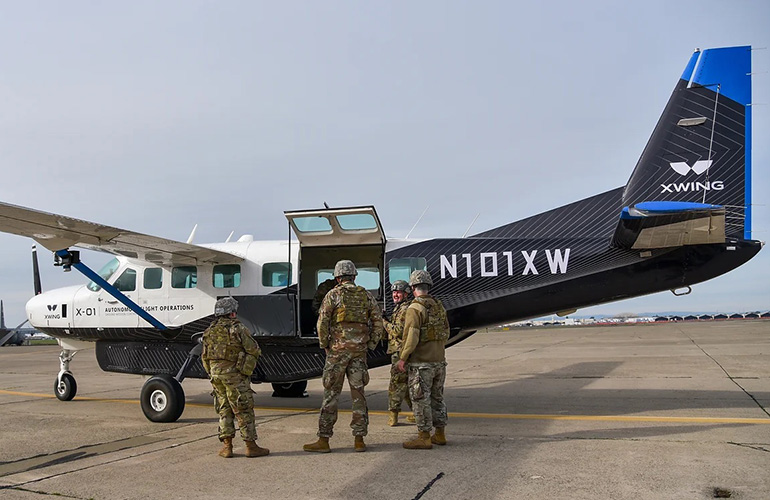|
Listen to this article  |

Xwing aircraft involved in USAF autonomy tests. Source: Xwing
A joint program by the U.S. Air Force and Xwing Inc. has demonstrated fixed-wing cargo-carrying capability in a point-to-point flight between two airbases using a specially modified Cessna 208B Grand Caravan.
In modern conflict, it’s axiomatic that logistics wins wars. And in an interconnected global economy, it also wins the peace.
In air freight alone, just under 16 million metric tons of cargo was flown worldwide in 2023. That represents a $335 billion market, and it’s not just dedicated cargo operators that benefit. For many airlines, cargo represents up to one-third of revenue. It’s a lot of freight, requiring lots of airframes, engines, and, of course, pilots.
The U.S. Air Force is naturally interested in the problem of air transport efficiency and has been investigating the possibilities of autonomous operation for years. The AFWERX innovation unit of the Air Force operates a research program called Autonomy Prime, which partners with private industry to accelerate testing of autonomous systems.
 Learn from Agility Robotics, Amazon, Disney, Teradyne and many more.
Learn from Agility Robotics, Amazon, Disney, Teradyne and many more.
Xwing advances autonomous flight
The program demonstrated a breakthrough on January 26, when program partner Xwing successfully completed a fully autonomous logistics mission, carrying cargo from March Air Reserve Base in Riverside, Calif., to McClellan Airfield near Sacramento.
The cargo run was performed using no human intervention at all. Advanced autopilot technology has been around for decades, as have drone fixed-wing aircraft and helicopters, so what makes this important?
Two aspects of the Autonomy Prime program are significant. The first is that point-to-point autonomous air cargo is instrumental to the Air Force Agile Combat Employment concept, which requires aircraft and equipment that are dispersed from major hub bases to smaller airfields to improve survivability. Doing this with crewed aircraft would be impossible without serious impact on conventional air transport operations.
The second, and possibly more significant impact, is that the Xwing test aircraft is not a prototype or military airplane. It’s a civil registered Cessna 208B Grand Caravan. The 208 is a popular light passenger and cargo aircraft already in extensive use by American cargo carriers for regional distribution, with a 3,000-lb. (1,360.7 kg) payload.
Technically, this means that the Xwing system has proven integration with aircraft systems in standard, certified designs, including conventional, mechanically operated control surfaces and standard engine management systems.
Conventional aircraft could go pilotless
The implication is clear: With the system already functioning well in an airframe already in common use by package delivery operators all over America, the replacement of the pilot in regional operations may only be a matter of Federal Aviation Administration approval. The test aircraft has been flying autonomously since 2020 and has 500 autonomous hours across 250 flights.
The future? A possible development is the automation of conventional aircraft to form optionally piloted systems, or cargo operators could use conventional flight crew for controlled airspace, then fly the final leg of the flight to remote destinations autonomously.
The end of the human pilot has been predicted for decades, and although the true robot airplane isn’t here yet, Autonomy Prime is bringing it one step closer.
Editor’s note: This article was syndicated from The Robot Report sibling site Engineering.com. Access all episodes of “This Week in Engineering” on Engineering.com TV.
Credit: Source link


Comments are closed.